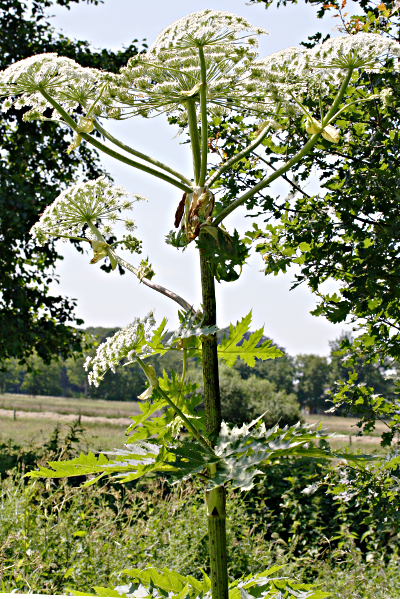Giant hogweed |

Giant hogweed

Giant hogweed - inflorescence
Dispersal
After the imposing plant was cultivated in other botanical gardens in Europe, they finally reached in private gardens and from there, for example by green waste, in nature. Sometimes it has even been planted deliberately in the nature, partly as fixing of embankments, partly as bee pasture. Unfortunately spurn the bees the giant hogweed, its pollinators are more likely to be found among the beetles and dipterans. In addition, the taproots destabilize the banks, rather than fix them.
In addition, the plant proved to be extremely competitive and spread all over Europe - the exotic plant became an invasive neophyte. The reason for this is firstly the high seed production. Assuming that the terminal umbel has 100 rays, each bearing 50 flowers, so to develop 5000 2-part schizocarps, ie a single plant produces 10,000 seeds. The lateral umbels, which generally contain functional male flowers, are not included in this bill, but they may also produce abundant fertile flowers. The fruits can be transported across distances of up to 10 meters by the wind, in the case of strong winds even much further. They are floatable up to 3 days, making the plant often settles along the banks.
The competition vigor of the plant from the Caucasus is also increased in that it grows very quickly and forms large leaves, which block the light and hinder native species from growing. Moreover, in their new habitat lacks the natural pests.
Health hazards caused by the giant hogweed
Not only the displacement of native species makes the giant hogweed dangerous, it is also hazardous to health. Its juice contains so-called furocumarines - chemical compounds that form under sunlight covalent bonds with components of the skin, such as proteins and lipids, and thus may trigger symptoms that are close to a 2nd degree burn. Even more dangerous it is, when furocumarines react with adenosine, one of the 4 bases of DNA. The strands of the double helix are thus interconnected, whereby no more transcription can be carried out. This can lead to cancer in extreme cases.Even when touching the plant, it can cause blisters on the skin. On warm days it is even possible that the toxins pass through evaporation into the air – then already the lingering under the plant can trigger a long-lasting bronchitis.